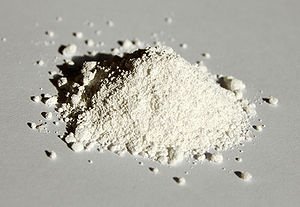
1,000 square metres of the coated panels eat up the equivalent NOx output of four cars
What material can you find in toothpaste, sunscreen, solar cells, on the baseline at Wimbledon, in a Roman church, and along a tunnel in Brussels?
Full marks if you guessed titanium dioxide, a nearly ubiquitous but wholly unsung material.
Its brilliant white has made it a staple in pigments – hence Wimbledon – but its eco-credentials are still coming to the fore.
Titanium dioxide does a couple of clever tricks that mean we may well be seeing a lot of it in the future: it’s self-cleaning, and it breaks down pollutants in the air.
And the fact that thin films of it are clear is the reason that a number of manufacturers use it in glass applications such as skylights.
Paving the way
The self-cleaning aspect comes about because one processed form of titanium dioxide is what is called superhydrophilic – literally, “water-loving”, which means that when water hits a dirty titanium dioxide surface, that surface will draw in a whisper-thin sheet of water across its whole surface, displacing grime that then washes neatly away.
But its second trick of removing pollutants is what has made it an increasingly popular choice for environmentally-minded building projects.
A bit of the ultraviolet light in sunlight frees up electrons from the material, creating “free radicals” that actively break down pollutants including so-called NOx gases (molecules of varying proportions of nitrogen and oxygen) or VOCs (volatile organic compounds).
A number of pilot projects around the world have seen the material used in, for example, concrete – hence the Jubilee Church in Rome. In Japan, Mitsubishi markets a brand of titanium dioxide-treated paving stones and Toto makes coated ceramic tiles.
The material hit the news again this week when the aluminium firm Alcoa announced its new product Ecoclean, a titanium dioxide coating on aluminium panels for cladding buildings.
The firm claims that 1,000 square metres of the coated panels eat up the equivalent NOx output of four cars.
“What we see, especially in Europe, is more and more legislation… about the air quality in cities, and I think that Ecoclean is a product that can really help mitigate the effects of emitters such as cars by its air-cleansing characteristics,” Alcoa spokesman Jasper Van Zon told BBC News.
Ecology of scale
The fact that such a large manufacturer has joined the ranks could mean that the real-world use of the material can finally be assessed on a large scale, says Anne Beeldens of the Catholic University Leuven in Belgium.
Dr Beeldens has been working with colleagues for years to establish, with rigorous experiments, the full scope of titanium dioxide’s effects in a built environment.
“We were really sceptical when we started with this, but it really works on the extraction of pollutants out of the air,” she told BBC News.
“The problem is that you have so many parameters that it’s sometimes hard to prove it. We got some promising results in the lab, but it was still in the lab; I think now it’s all shifting to real applications.”
Read more . . .
Bookmark this page for “titanium dioxide” and check back regularly as these articles update on a very frequent basis. The view is set to “news”. Try clicking on “video” and “2” for more articles.







